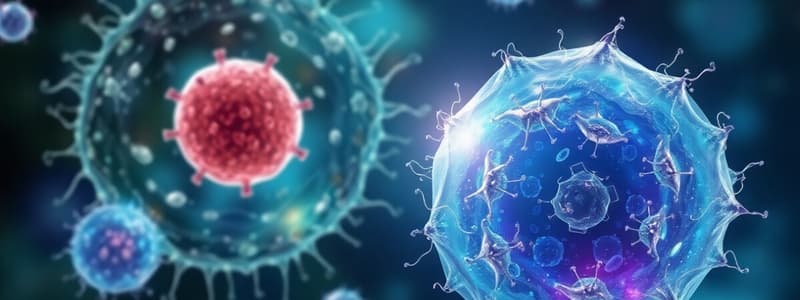Podcast
Questions and Answers
What key feature distinguishes prokaryotic cells from eukaryotic cells?
What key feature distinguishes prokaryotic cells from eukaryotic cells?
- Presence of ribosomes
- Ability to form multicellular organisms
- Presence of a membrane-bound nucleus (correct)
- Size of the cell
Which of the following statements about prokaryotic cells is true?
Which of the following statements about prokaryotic cells is true?
- Their genetic material is found in a nucleoid region. (correct)
- They possess membrane-bound organelles.
- They are primarily multicellular organisms.
- They cannot form colonies.
Eukaryotic organisms include which of the following?
Eukaryotic organisms include which of the following?
- Fungi (correct)
- Viruses
- Archaea
- Bacteria
Which classification methodology is used for naming and classifying organisms?
Which classification methodology is used for naming and classifying organisms?
What does the term 'eukaryote' refer to in biological classification?
What does the term 'eukaryote' refer to in biological classification?
Which of the following is NOT a characteristic of prokaryotic cells?
Which of the following is NOT a characteristic of prokaryotic cells?
What term describes the grouping of organisms into hierarchical categories?
What term describes the grouping of organisms into hierarchical categories?
Which of the following best describes the genetic material in prokaryotic cells?
Which of the following best describes the genetic material in prokaryotic cells?
What is the main component of cell membranes?
What is the main component of cell membranes?
What allows the phospholipid head to be soluble in water?
What allows the phospholipid head to be soluble in water?
What are the functions of cholesterol in the cell membrane?
What are the functions of cholesterol in the cell membrane?
What role do integral proteins play in the cell membrane?
What role do integral proteins play in the cell membrane?
Channel proteins require energy to transport molecules across the cell membrane.
Channel proteins require energy to transport molecules across the cell membrane.
The process of moving substances against a concentration gradient is known as ______ transport.
The process of moving substances against a concentration gradient is known as ______ transport.
Match the following components with their functions:
Match the following components with their functions:
Flashcards are hidden until you start studying
Study Notes
Cell Types Overview
- Cells are categorized into two main types: prokaryotic and eukaryotic.
- Prokaryotic cells are typically unicellular and lack membrane-bound organelles.
- Eukaryotic cells can be unicellular or multicellular and possess membrane-bound organelles.
Prokaryotic Cells
- Genetic material of prokaryotes is found in a region called the nucleoid.
- Prokaryotes do not have a true nucleus; their genetic material is suspended in the cytoplasm.
- Exhibit various arrangements: single, pairs, chains, clusters, aggregates, and colonies.
Eukaryotic Cells
- Eukaryotic cells contain a true nucleus; the term "eukaryote" derives from "eu" (true) and "karyon" (nucleus).
- Include organisms such as protozoans, algae, fungi, plants, and animals.
- Eukaryotic cells can function independently as single-celled organisms or as part of multicellular structures.
Taxonomy
- Taxonomy is the science of naming and classifying organisms.
- It involves systematic classification of plants and animals in hierarchical groups.
- Linnean Binomial Nomenclature is the method used for naming organisms, reflecting their classification.
Adaptations in Cell Structure
- Cells may undergo modifications to adapt and perform specialized functions, which illustrates the diversity of life forms.
- Understanding cell structure and function is crucial for studying biological systems and the evolution of life.
Learning Objectives
- Distinguish prokaryotic and eukaryotic cells based on key features.
- Classify different types of cells and specify their functions.
- Describe cellular modifications that allow adaptation for specialized tasks.
Learning Objectives
- Describe structural components of the cell membrane.
- Relate cell membrane structure to its function.
- Explain how the cell membrane regulates material transport.
- Differentiate between endocytosis and exocytosis.
Cell Membrane Overview
- Separates intracellular and extracellular environments.
- Enables specific chemical exchanges vital for life.
- Composed of a semipermeable phospholipid bilayer.
Phospholipid Bilayer
- Main component of cell membranes.
- Phospholipids arrange in a bilayer, creating a barrier against water-soluble molecules.
Phospholipid Structure
- Comprises a polar hydrophilic head (glycerol + phosphate group) and two non-polar hydrophobic tails (fatty acids).
- Amphipathic nature: possesses both hydrophilic and hydrophobic regions.
Cholesterol in Cell Membrane
- Regulates membrane fluidity.
- Prevents phospholipids from packing too closely, reducing membrane freezing risk.
Membrane Proteins
- Integral proteins span the bilayer and facilitate diffusion and cell recognition.
- Transport proteins traverse the bilayer to aid the movement of substances.
- Channel proteins allow passive transport of ions and polar molecules along concentration gradients.
- Carrier proteins can change shape to transport substances across gradients.
Glycoproteins and Glycolipids
- Glycoproteins have carbohydrate chains that function as receptors and cell markers for recognition.
- Glycolipids stabilize the membrane and support immune responses via hydrogen bonding with water molecules.
Transport Mechanisms in Cells
- Cell membranes regulate solute movement using embedded proteins for various functions.
- Four processes for solute transport:
- Passive diffusion: Movement down a concentration gradient without energy.
- Carrier-mediated transport: Movement down a gradient using carrier proteins.
- Primary active transport: Movement against a gradient, requiring energy.
- Secondary active transport: Co-transport against a gradient, utilizing energy indirectly.
Passive Transport
- Involves movement of substances without energy expenditure, relying on membrane permeability.
Studying That Suits You
Use AI to generate personalized quizzes and flashcards to suit your learning preferences.




